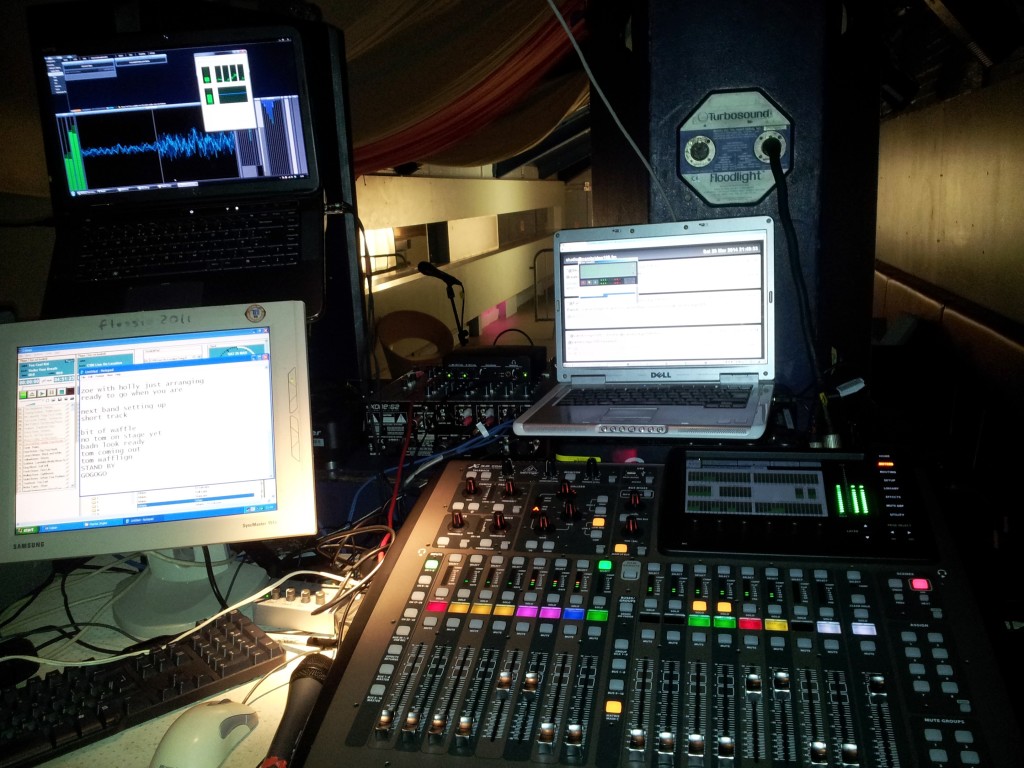As many of you will be aware, one of my many volunteer roles is as an Outside Broadcast Engineer at Cambridge 105, Cambridge’s Community FM radio station.
There are essentially two types of Outside Broadcast music events that we run: those where we do the live music mix, and those where we just take an existing feed and add to it. One of the latter sort of event was our live broadcast from the Cambridge Band Competition at The Junction on 29th March 2014. This is the behind-the-scenes engineer’s view.

So, what’s going on here?
- The mixing desk (a Behringer X32 Compact) is receiving a feed from the Front-of-House (FoH) mix, provided by the venue. This stereo pair is the set of faders that are up on the left-hand bank.
- For some events, we have our own additional mics to get guitar amps (which won’t be fed much/at all to the FoH) and an audience mic so we get the applause at the end. This comes to our mixing desk via a separate feed. (At The Junction, we had the luxury of a set of tie-line from the stage to the room we used for our mix. Normally, we use a Behringer Digital Snake S16 over Ethernet)
- The Cambridge 105 presenter needs to be able to play pre-recorded music between sets. We use Caban for this, which is on the main left-hand monitor. The presenter(s) have their mics on separate channels on the mixing desk, of course, and the PC takes up another channel.
- So far, so easy. But the presenter can’t see the stage, and so won’t know when to stop talking, or when to keep waffling. This is a good thing, because a broadcast mix is often sufficiently different from the FoH that we want to mix in an isolated environment. To solve the lack of visibility, however, one of the engineering team (most commonly yours truly) stands next to the stage with a radio mic and set of wireless headphones, and I relay what’s going on. My wireless headphones are supplied with a mix of this talkback and what’s going to air.
- We also often have a reporter interviewing the acts as they come off stage. That reporter has another pair of wireless headphones (also fed with the talkback + broadcast feed) and another radio mic.
- The presenter’s headphones are just fed with the off-air feed, not the talkback to avoid distractions. The mixing desk operator can type important messages to the presenter in a Notepad window on the same monitor as Caban.
- The output from the mixing desk is fed to the laptop in the top-left, which is running Stereo Tool for broadcast compression. We sometimes also use Reaper to record the multi-track output from the desk. Typically, the compressor adds just under a one second delay.
- From there, the output of that laptop goes into the laptop on the top-right, which is running Butt, to IP stream the broadcast to the Cambridge 105 studio. The IP stream adds another couple of seconds’ delay.
- The laptop on the top-right also displays the studio email, where we get listener input, as well as automatic notifications if the stream should fail.
- At the studio, a computer feeds this to the analogue mixing desk in Studio A, where the feed magically appears on a single stereo fader marked ‘Remote’.


